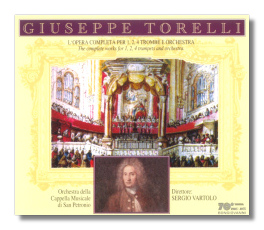
The Internet's Premier Classical Music Source
Related Links
- Latest Reviews
- More Reviews
-
By Composer
-
Collections
DVD & Blu-ray
Books
Concert Reviews
Articles/Interviews
Software
Audio
Search Amazon
Recommended Links
Site News
 CD Review
CD Review
Giuseppe Torelli

Complete Works for 1, 2 & 4 Trumpets
- Sinfonias in D Major, G. 1-11, 13, 26, 29-31
- Sinfonia à 4 in C Major, G. 33
- Concertos in D Major, G. 27 & 32
- Sonatas in D Major, G. 15-25
Orchestra della Cappella Musicale San Petronio/Sergio Vartolo
Bongiovanni GB 5523/24/25-2 1994 DDD 3CDs: 60:50, 63:38, 58:41
Back in the 60s, Columbia visited San Marco in Venice with E. Power Biggs, the Gregg Smith Singers, the Texas Boys Choir, and the Edward Tarr Brass Ensemble to produce The Glory of Gabrieli (MS 7071) taking advantage of the two choir lofts on opposite sides of the church. The recording was a landmark because the plan and acoustics of San Marco had originally inspired this music – and much to follow. The opposing lofts are as famous a feature of the basilica as its mosaics, yet the priests were puzzled when Columbia Records knocked at their door. They had never heard of Gabrieli and couldn't understand why anyone else had. The recording created a sensation when it was released in April 1968. There were lots of people involved; but of all the performers, the church itself was unquestionably the star.
Bongiovanni has now completed a similar project in the Church of San Petronio in Bologna. The acoustics of that former musical center also played a role in the creation of the music to be recorded. Torelli's concerted music for trumpets, oboes, and strings can be fully understood only in this setting. The slow movements, for example, feature well-spaced staccato chords that must have echoed for almost the full 12-second reverberation time for which San Petronio is notorious. (Those 12 seconds played havoc with the coordination of ensembles stationed in various parts of the church. They still do.) As in the epic recording in San Marco, Edward Tarr was on hand, this time performing on natural trumpet.
What a celebration of D Major: almost three hours (just one Sinfonia is in C) in that key! Most of the individual works are about six minutes long – and there are plenty of them. They come in all kinds of combinations (and with titles that vary – sinfonia, concerto, sonata).
Although the sequences of movements are predictable, beyond that all bets are off. There's a surprise in almost every piece: a sudden solo by violin (Torelli was himself a violinist) or a duet for violins or even trumpet and cello. What a contrast to the stately Fortspinnung of Corelli.
Because of the reverberation time, not everyone in the church could hear all this detail – there were only one or two "sweet spots," and it's anyone's guess who got to sit there (if you guessed Bologna's city officials, you win the round). Ironically, the musicians themselves had to communicate visually because they couldn't hear as well as their privileged listeners. With the release of this set, however, every listener can take a seat among the nobility. With the brilliant final chords majestically decaying over a seemingly endless span of seconds, this musicological document establishes its authenticity effortlessly. The performances, on instruments of the period, are brilliant; the engineering is perfectly adapted to the mission of reproducing the music as it was originally conceived; and the generous booklet, with its detailed notes and photographs of the ensemble, positioned as it was 300 years ago under Torelli himself, enables the listener to appreciate fully the privilege he enjoys in listening to these discs.
Each decade produces a few great recordings and a few historically important ones. Only rarely does a recording belong in both categories.
Make that three for the three discs in this set. Congratulations are in order for everyone: performers, engineers, writers, producers.
Copyright © 1996, Robert Maxham


















